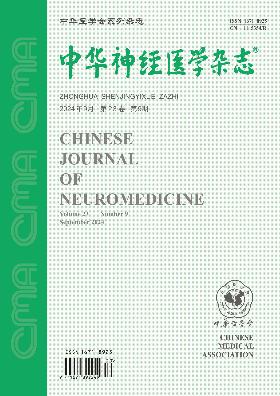Effect of combined therapy of radiosurgery and temozolomide on U87-epidermal growth factor receptor and variant III cells and their xenograft
Q4 Medicine
引用次数: 0
Abstract
Objective To explore the effect of radiosurgery in combination of temozolomide therapy in vitro and in vivo on invasion and endocrine function of human glioma cell line U87-epidermal growth factor receptor and variant III (EGFRvIII) and their xenograft. Methods (1) Human glioma U87-EGFRvIII cells were routinely cultured; CCK-8 was used to detect the effect of temozolomide at different concentrations on proliferation of U87-EGFRvIII cells, and the semi-inhibitory concentration (IC50) of temozolomide was calculated; the U87-EGFRvIII cells were divided into control group, 6 Gy radiotherapy group and 12 Gy radiotherapy group, and the expressions of invasion-related proteins and gene repair proteins in the three groups were detected by Western blotting after 0, 6 and 12 Gy edge-dose irradiation, respectively; the U87-EGFRvIII cells were divided into control group, 6 Gy radiotherapy group and 6 Gy radiation combined with temozolomide treatment group (5 mmol/L temozolomide was added after 6 Gy irradiation), and 24 h after each treatment, Western blotting was used to detect the expressions of invasion related proteins and gene repair related proteins in the three groups. (2) Nude mouse transplantation intracranial glioma models were established with cell suspension of the control group, 6 Gy radiotherapy group and 6 Gy radiation combined with temozolomide treatment group; 7, 14, 21 d after transplantation, bioluminescence imaging (BLI) was employed to detect luciferase expression in nude mice in vivo and measurement of transplanted tumors was performed; survival curve and body mass curve were drew in nude mice; immunohistochemical staining was used to detect the expressions of EGFRvIII, epidermal growth factor receptor (EGFR), matrix metalloproteinase (MMP)-9, vascular endothelial growth factor (VEGF) and Ki67 in intracranial transplanted gliomas. Results (1) The IC50 of temozolomide on U87-EGFRvIII cells was 5 mmol/L; as compared with those in the control group, the expressions of EGFRvIII, EGFR, MMP-2, MMP-9, VEGF, MGMT, AKT-1, β-catenin and Ku70 significantly increased in the cells of the 6 Gy radiotherapy group, while the expressions of EGFRvIII, EGFR, MMP-2, MMP-9, VEGF, MGMT, AKT-1, β-catenin and Ku70 significantly decreased in the cells of the 12 Gy radiotherapy group as compared with those in the 6 Gy radiotherapy group (P<0.05); as compared with those in the 6 Gy radiotherapy group, the expressions of EGFRvIII, EGFR, MMP-2, MMP-9, VEGF, MGMT, AKT-1, β-catenin and Ku70 in cells of the 6 Gy radiotherapy combined with temozolomide group were statistically decreased (P<0.05). (2) As compared with mice in the control group and 6 Gy radiotherapy group, mice in the 6 Gy radiotherapy combined with temozolomide group had significantly lower cell tumorigenicity, significantly higher survival rate and body mass 21 d after transplantation, and significantly smaller volume of xenograft tumors (P<0.05); the expressions of EGFRvIII, EGFR, MMP-9, VEGF and Ki67 in tumor tissues of nude mice in the 6 Gy radiotherapy group were significantly decreased as compared with those in the control group; as compared with those in the 6 Gy radiotherapy group, the expressions of EGFRvIII, EGFR, MMP-9, VEGF and Ki67 in tumor tissues of mice in the 6 Gy radiotherapy group were significantly decreased (P<0.05). Conclusion The combined treatment of radiosurgery and temozolomide can more obviously inhibit the invasiveness of U87- EGFRvIII cells and it exerts a stronger inhibitory effect on tumorigenicity of U87-EGFRvIII cells in brain of nude rats. Key words: Epidermal growth factor receptor and variant III; Mutation; Radiotherapy; Temozolomide; Invasion; Proliferation放射外科联合替莫唑胺对u87 -表皮生长因子受体和变异III细胞及其异种移植物的影响
目的探讨放射外科联合替莫唑胺治疗对人胶质瘤细胞系u87 -表皮生长因子受体及其变体III (EGFRvIII)及其异种移植物侵袭及内分泌功能的影响。方法(1)常规培养人胶质瘤细胞U87-EGFRvIII;采用CCK-8检测不同浓度替莫唑胺对U87-EGFRvIII细胞增殖的影响,计算替莫唑胺的半抑制浓度(IC50);将U87-EGFRvIII细胞分为对照组、6 Gy放疗组和12 Gy放疗组,分别在0、6和12 Gy边缘剂量照射后,用Western blot检测三组细胞中侵袭相关蛋白和基因修复蛋白的表达;将U87-EGFRvIII细胞分为对照组、6 Gy放射治疗组和6 Gy放射联合替莫唑胺治疗组(6 Gy放射后加入5 mmol/L替莫唑胺),每次治疗后24 h,采用Western blotting检测三组细胞中侵袭相关蛋白和基因修复相关蛋白的表达。(2)对照组、6gy放疗组和6gy放疗联合替莫唑胺治疗组分别建立裸鼠移植颅内胶质瘤模型;移植后7、14、21 d,采用生物发光成像(BLI)法检测裸鼠体内荧光素酶的表达并测量移植肿瘤;绘制裸鼠生存曲线和体重曲线;采用免疫组化染色法检测颅内移植胶质瘤组织中EGFRvIII、表皮生长因子受体(EGFR)、基质金属蛋白酶(MMP)-9、血管内皮生长因子(VEGF)和Ki67的表达。结果(1)替莫唑胺对U87-EGFRvIII细胞的IC50为5 mmol/L;与对照组相比,6 Gy放疗组细胞中EGFRvIII、EGFR、MMP-2、MMP-9、VEGF、MGMT、AKT-1、β-catenin、Ku70的表达显著升高,12 Gy放疗组细胞中EGFRvIII、EGFR、MMP-2、MMP-9、VEGF、MGMT、AKT-1、β-catenin、Ku70的表达显著降低(P<0.05);与6 Gy放疗组比较,6 Gy放疗联合替莫唑胺组细胞中EGFRvIII、EGFR、MMP-2、MMP-9、VEGF、MGMT、AKT-1、β-catenin、Ku70的表达均有统计学意义降低(P<0.05)。(2)与对照组和6 Gy放疗组相比,6 Gy放疗联合替莫唑胺组小鼠细胞致瘤性显著降低,移植后21 d存活率和体质量显著提高,异种移植肿瘤体积显著缩小(P<0.05);6 Gy放疗组裸鼠肿瘤组织中EGFRvIII、EGFR、MMP-9、VEGF、Ki67的表达均较对照组显著降低;与6 Gy放疗组相比,6 Gy放疗组小鼠肿瘤组织中EGFRvIII、EGFR、MMP-9、VEGF、Ki67的表达均显著降低(P<0.05)。结论放射外科联合替莫唑胺能更明显地抑制U87-EGFRvIII细胞的侵袭性,对裸鼠脑内U87-EGFRvIII细胞的致瘤性有较强的抑制作用。关键词:表皮生长因子受体及其变体III;突变;放射治疗;Temozolomide;入侵;扩散
本文章由计算机程序翻译,如有差异,请以英文原文为准。
求助全文
约1分钟内获得全文
求助全文
来源期刊

中华神经医学杂志
Psychology-Neuropsychology and Physiological Psychology
CiteScore
0.30
自引率
0.00%
发文量
6272
期刊介绍:
 求助内容:
求助内容: 应助结果提醒方式:
应助结果提醒方式:


